Book contents
- Frontmatter
- Contents
- List of figures
- List of tables
- Acknowledgements
- List of abbreviations
- 1 Introduction
- 2 Attainment in naturalistic SDA
- 3 Acquiring a second dialect
- 4 Differential attainment: Age effects and linguistic factors
- 5 Additional individual and linguistic factors
- 6 The difficulty of SDA
- 7 SDA in classroom contexts
- 8 Educational approaches for SDA
- 9 Explaining the results and taking further steps
- Notes
- References
- Index
8 - Educational approaches for SDA
Published online by Cambridge University Press: 07 September 2010
- Frontmatter
- Contents
- List of figures
- List of tables
- Acknowledgements
- List of abbreviations
- 1 Introduction
- 2 Attainment in naturalistic SDA
- 3 Acquiring a second dialect
- 4 Differential attainment: Age effects and linguistic factors
- 5 Additional individual and linguistic factors
- 6 The difficulty of SDA
- 7 SDA in classroom contexts
- 8 Educational approaches for SDA
- 9 Explaining the results and taking further steps
- Notes
- References
- Index
Summary
This chapter is concerned with the educational approaches and programs that have been used specifically for the purpose of assisting the acquisition or use of another dialect. The characteristics of each of these are described, as well as any evaluative research that is available.
The chapter starts off with depicting two types of dialect teaching that normally do not occur in the classroom: dialect coaching and accent modification. As mentioned in Chapter 7, students in such programs are usually adults who are interested in acquiring the phonological features of another dialect for professional purposes. The remaining sections deal with classroom approaches for younger students who are required to learn the standard dialect in the formal education system. Some historical background is first presented about approaches and methodologies used in the 1960s and 1970s. Then, three types of current approaches are described: instrumental, accommodation and awareness.
Dialect coaching and accent modification
Dialect coaching
In Chapter 3, I talked a bit about actors' imitations of dialects, and mentioned that most actors who perform in dialects other than their own have used a dialect coach. There are dozens of websites on the internet for dialect coaches (or voice coaches) – often with lists of films, plays and other productions that they have worked on. Two well-known examples are Victoria Mielewska in Australia and Paul Meier in the USA. There is also an association of dialect coaches and related professionals: the Voice and Speech Trainers Association (VASTA), which has a newsletter, accessible over the internet (www.vasta.org).
- Type
- Chapter
- Information
- Second Dialect Acquisition , pp. 192 - 218Publisher: Cambridge University PressPrint publication year: 2010

